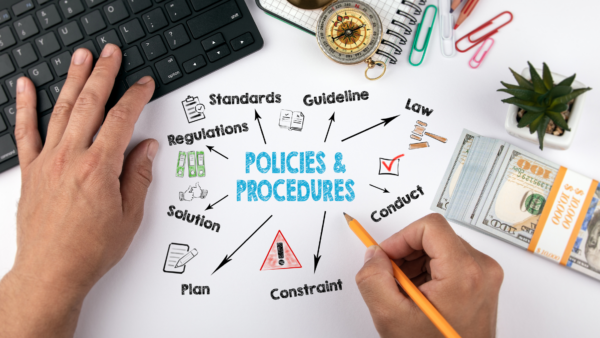In general, biases help people make decisions. With so many choices to make each day, the human brain would be overwhelmed without a few unconscious preferences helping us along. And because our brains are wired to help us quickly detect danger, we tend to gravitate towards people, places, or experiences that are familiar. We subconsciously register these things as safe.
On the other hand, new experiences, people, ideas, or places are often interpreted as “dangerous” and the brain warns us to “stay away.” For example, we might be more comfortable with people who look like us, are from our hometown, or enjoy similar hobbies. At the same time, we might unintentionally avoid people who are different, because our brain registers “unfamiliar” as “unsafe.”
Unchecked, bias can lead to discrimination, harmful stereotyping, and prejudice. Even when we’re doing our best to treat others fairly, unconscious biases can still influence our behavior. So while it might take a little time and effort to overcome any implicit bias, it’s important that we try. People aren’t unsafe just because they’re unfamiliar.
There’s good news, though. Even though we all have unconscious biases, there are ways to mitigate their impact. If you’re ready to get proactive about overcoming bias in your workplace, we’ve gathered solutions and suggestions that you can put into action today! Keep reading for 12 ways to foster inclusion and make everyone feel welcome at work.
What is bias in the workplace?
What does it look like when bias influences the choices we make at work?
Here are a few examples: bias is when a man gets offered new projects over a woman based on the manager’s belief that men are harder workers. Or when the resume of a BIPOC person gets passed over because the hiring team thinks they won’t be a “culture fit.” Or when someone who graduated from a state school isn’t respected by their Ivy League colleagues.
In all these cases, people come to conclusions based on faulty assumptions and then act on them. When we allow this kind of behavior to continue in the workplace, it weakens our companies from the inside. Our teams are less effective, employees are less engaged, and people don’t feel welcome to be themselves. Overall, studies show that employers with less inclusive cultures see worse decision-making, decreased productivity, and more turnover.
What are the different types of biases in the workplace?
There are several different types of unconscious bias. The types that impact our workplaces can be sorted into three categories: identity-related bias, knowledge and cognitive bias, and decision-making bias.
Identity-related bias
When someone is treated differently because of personality traits or qualities, it’s due to an identity-related bias. Characteristics like gender, race, age, ability, sexual orientation, or ethnic background influence come into play. Other attributes, such as someone’s dress or physical appearance, religion, or socioeconomic background could spark identity-related bias too.
For example, being warm and polite to someone dressed in expensive brand-name clothing, while speaking rudely to someone in second-hand clothes is a harmful form of identity-related bias. Not including a quiet person in team building events could be due to bias against introverts. And refusing to use someone’s preferred pronouns is a form of bias against LGBTQ+ people. Everyone is worthy of respect, no matter where they come from or what they look like.
Cognitive and knowledge bias
A few factors influence knowledge-based or cognitive biases. Perceived intelligence could shape how someone is treated. A person’s educational background could influence how others treat them too. For instance, if someone is treated more kindly because they are university-educated, versus someone who learned a trade, this is a form of knowledge bias.
The language one speaks could also influence cognitive bias. Someone who is still learning to speak fluently in another’s language might not be treated as well as someone who is a native speaker. Others might assume they are less intelligent or capable, even though this is not the case.
Decision-making
When we aren’t intentional about our decision-making process, we can be swayed by different kinds of bias. One form of this is confirmation bias, which is when we look for answers that reinforce our already-held beliefs. Another type is the halo effect, which is when we assume something positive about others because they’re associated with a brand we like or an activity we enjoy.
Other potential biases include affinity bias, recency bias, and groupthink. Affinity bias is when we demonstrate preferential treatment to those who are similar to us, while recency bias is when we prefer people who are freshest in our memory. Groupthink is when we go with the flow of the crowd, instead of thinking critically on our own. It’s important to be aware of these kinds of decision-making biases so that we can counteract them.
Consequences of interview bias at work
Favoring one group of people while excluding others is wrong. Not only that, it has a negative impact on our companies. When bias influences our workspaces, there’s less diverse talent, less innovation, less financial growth, and lower morale. People who face bias perform poorly. There’s increased conflict and increased difficulty with both recruiting and retention.
Bias is like a sickness—it might start small, with just an off comment or two, but it has the potential to grow and infect entire departments, businesses, and even industries. Get proactive about mitigating bias, and keep it from influencing your workplace too.
Increasing inclusion in the workplace
Building more inclusive workplaces is essential for true success. Adopt a few (or all!) of these practices to avoid bias in your workplace and create a space where all employees are welcomed and empowered.
1. Educate your team
To get buy-in from your employees, make a case for why inclusion and bias reduction are so important. Share meaningful training opportunities with employees that raise awareness about the prejudices people face in and out of the workplace. Teach hiring managers, leadership, and other employees about the ways bias interferes with hiring, promotions, and team dynamics. When employees know what to watch out for, they’ll be able to identify and correct any behavior they see within themselves or others.
2. Review and revise policies
Does your company have policies that reinforce inclusion? If there is no clear message about the importance of inclusion in the workplace, consider developing a statement or set of policies. Include equal opportunity statements in job posts, develop a transparent scoring system for evaluating job applicants or guiding promotions, and establish a system for employees to report concerns.
3. Set goals
Track hiring and promotion demographics to surface patterns. Review productivity, turnover, and employee engagement. Either identify gaps or continue to measure success. If your organization is attracting only one or two types of candidates, consider adjusting your hiring strategy to attract and include candidates from a variety of backgrounds in your talent pool. To increase the range of people in leadership positions, set goals related to offering career opportunities. If your company is seeing high turnover, develop a plan to improve your interview process to find better-fit candidates and ensure you’re communicating job expectations upfront. Continuously track your progress so you know what practices to adjust, or what to do more of.
4. Celebrate differences in the workplace
It’s hard to maintain an inclusive workplace without a strong foundation. Take steps to enforce cultural values that promote unity. Strengthen your teams with ERG groups, mentorship programs, and ongoing education. Take time to recognize and celebrate different communities during national recognition days or months. One of the most important ways your company can demonstrate a commitment to inclusion is to continue to build teams that include people of different backgrounds. Commit to a hiring process that gives all job seekers a fair chance to succeed.
5. Encourage the use of inclusive language
Promote respectful and inclusive language throughout your organization. One easy fix is to avoid exclusionary language in company policies, marketing content, or job descriptions. In the same way, avoid language that perpetuates stereotypes or is difficult for people to understand. Consider using smart recruiting technology to evaluate language and help HR leaders develop job ads that are intentionally more inviting. Tools like this can also be used to ensure inclusion in marketing materials, slide decks, or company-wide communications.
6. Address microaggressions
One of the first steps towards inclusion is to avoid microaggressions in the workplace. Microaggressions include putdowns, slights, and invalidating or demeaning comments. They can be intentional or unintentional, but all comments of this nature indicate prejudice or biased underlying beliefs. Even subtle word choices in casual conversation will undermine efforts to improve your overall company culture. Educate yourself and others about how microaggressions manifest at work, and speak up when you notice them.
7. Prioritize objective decision-making
Decision-makers shouldn’t just hire people who they like or get along with. While it’s important that employees form a cohesive team, make sure you aren’t weighing how well-liked a person is over more important factors. It’s more valuable to consider someone’s adaptability, creativity, or communication skills. Consider using candidate scorecards to make more objective, accurate hiring decisions. If applicable, provide skills-based testing. And review interview records, such as recordings or transcripts, to make decisions, rather than relying on memory or gut feelings.
8. Implement inclusive hiring practices
Enhance inclusive language in job descriptions to attract as many qualified candidates as possible. Add benefits and salary details to job ads for enhanced transparency and a wider range of applicants. Use blind resume reviews to remove details that could interfere with a recruiter’s ability to fairly assess applicants. Incorporate video interviews into the hiring process to create an accurate record and identify opportunities for interviewer coaching.
9. Use structured interview processes
Use intelligent interview software for video interviews, or a template for in-person interviews to guide each candidate interaction. This ensures interview questions are legal, appropriate, and relevant. Following a set of pre-selected questions will help combat types of unconscious bias that could influence the interviewer. Using structured questions makes it easier to accurately assess candidates and avoid distracting small talk. Structured interviews make comparing and contrasting each candidate’s profile with other potential hires more straightforward too.
10. Continuously audit your hiring practices
Regularly use data to examine your interview process as a whole. If adjustments are necessary, implicit association tests like Project Implicit can be a helpful way to learn which unconscious biases impact decision-making. It’s a good idea, too, to review your employee referral program. These programs can be helpful, but they can also lead to a flood of employees from the same educational, socioeconomic, or cultural backgrounds. You’ll build an imbalanced talent pool, which isn’t helpful for companies that value a range of perspectives and diverse backgrounds. Always be ready to make changes as needed.
11. Create feedback channels
For long-term success, make it easy for employees to provide suggestions or report concerns. Debrief any situations that might have caused harm, and think of ways to avoid them in the future. Work together to creatively problem-solve and improve processes for all. If you’re striving to build a more welcoming hiring process, survey new hires or applicants to better understand their personal experiences and the impact of your inclusion efforts.
12. Hold leadership and employees accountable
Hold leadership and management accountable for creating and maintaining a workplace that promotes inclusion. Create a task force to monitor promotion or hiring rates, and review interview records for compliance. Use feedback channels or an independent auditing group to evaluate processes for inclusion. Ensure projects or tasks are assigned fairly to team members, not just people most friendly with their managers. Instead, encourage leaders to delegate and assign roles based on skill. Foster an organizational culture where standing up for colleagues is welcomed, and set the right tone from the top down.
As you progress on your journey to greater unity, know that there are many ways to begin reducing bias in the workplace. From audits to education to feedback channels, approach inclusion from every angle. It’s worth the attention and effort.
Increasing inclusion in the hiring process
Bias is harmful both in and out of work. It’s especially damaging to companies that want to build inclusive and effective teams. For companies building or strengthening a foundation of inclusion, adjusting the hiring process is a great place to start. Break your approach down into manageable phases, and you’ll be able to improve every step of your interview process.
With the right interviewing tools, you’ll find it easier to find better candidates and combat bias at the same time. Consider enhancing outreach language and job ads with inclusive language tools. Provide consistent interviews with question guides, and continue to uplevel your interviewer’s skills with the coaching that video interviews allow for. Evaluate candidates with uniform scorecards and review interview highlights and transcripts to make decisions based on accurate records, not faulty memory. Across the hiring cycle, commit to making better, bias-free, decisions.
Start reducing bias at your organization today
With structured interviews, job description templates, and other growth-oriented interview tools, Clovers can help get you where you want to be. Find the support you need to bring your hiring strategy into the future—with a more fair, insightful, and efficient process—and talk to a team member today. You’ll find less bias, more inclusion, and a new level of success.






